For Faster Service Call Directly
FREE ESTIMATE
Request Your Pest Control Estimate
There are many reasons why bees, wasps, and hornets swarm around yards in this region of the country. At the top of the list is warm weather. When the winter cold has passed and temperatures get up above a constant 50 degrees, these stinging insects become active again and stay active till temperatures drop back down. (This can be as early as April until as late as October.)
Another key factor in bee, wasp, and hornet activity is the availability of food. If you have lots of flowers or flowering plants on your property, you're going to get visits from these insects.
That isn't necessarily bad, however. Stinging insects help with pollination.
Without them, we wouldn't have honey, chocolate, coffee, vanilla, almonds, cashews, berries, bananas, grapes, avocados… The list of foods and drinks we would no longer have is extensive. As long as these stinging insects do not create nests or hives on or inside your property, it is good to have them around.
Request Your Pest Control Estimate
While wasps and hornets feed on the nectar of flowers, a large portion of their diet comes from protein sources. If you have lots of crawling and flying bugs on your property, you're likely to have more trouble with wasps and hornets establishing nests.
At American Pest, we offer residential pest control services that work to manage bee, wasp and hornet threats, while keeping in mind that these insects are important to our ecosystem. We use green solutions first and only resort to pest control products when a threat warrants the need for greater control. If you're dealing with stinging insects, you can trust the highly trained and experienced team at American Pest to resolve your issue appropriately.
Make sure your exterior trash is in sealed receptacles. Many stinging insects are drawn to the smell of organic matter in trash.
Refrain from feeding pets outside. Some pet foods attract stinging insects.
Locate and fill in holes in your yard to prevent yellow jackets and other stinging pests from developing nests in the ground.
Everything you do to reduce bugs will help reduce stinging insects that feed on them.
Remove standing water and the conditions that promote standing water, thus removing drinking holes for stinging pests.
Inspect your door and window screens to make sure they are in good-working condition.
Keep your eye out for developing nests and contact a licensed professional if you see a nest forming or you notice stinging insects going in and out of a gap in your home.
Always wear footwear when walking around in your yard.
If you hear buzzing, take notice of holes, gaps, or cracks where bees, wasps, or hornets are entering and exiting.
Refrain from wearing bright-colored clothing with flower patterns or applying perfume or cologne before going outside. These will attract unwanted attention.
If a stinging insect comes near, slowly move away without swinging your arms quickly.
Fill in holes, remove standing water, and address conditions that promote an increase in bug populations. This will reduce habitat, food, and water options for stinging insects.
If you're having a cookout, keep your food in sealed containers until it is time to put them on the grill. When you're done eating, dispose of paper plates, etc. in a sealed plastic bag.
Make sure exterior trash bags are put into sealed receptacles.
Refrain from wearing sweet smells or from having objects that produce sweet smells around your home.
Inspect your home for evidence of stinging insects going in and out of gaps, cracks, or holes. If you notice activity, contact a licensed professional.
Fill in gaps cracks, or holes in your foundation or exterior to keep overwintering queens from getting in.
Inspect your door and window screens and repair any damage. Do a check of the frames as well. If you see gaps that could allow stinging insects to get between your screens and your door or window panes, apply something to create a seal.
Make sure to rake leaves away from your home and remove them from your property. Leaves create conditions that allow bugs to thrive. More bugs will make your property more interesting to stinging insects that eat them
Cautiously inspect your attic space for the presence of bees, wasps, or hornets. They can establish nests in stored furniture and other stored items.
They may also attach a nest to your rafters or in an accessible void. Listen and look for signs. If you see any, reach out to a licensed professional to address the problem.
Apply screen material to the inside of your attic vents. This will help keep stinging insects from getting in and creating a nest in the spring.
Inspect your basement or attic and look for spots where you feel cold air coming in. If you sense a draft, it is possible that you have an entry point large enough for a stinging insect to get in and create a nest.
There are many stinging insects that can visit your property. Here are a few of the most common:
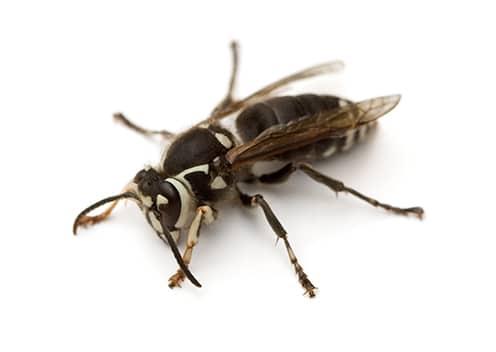
Baldfaced Hornets
If you see stinging insects in your yard that are between 5/8 of an inch and 1/2 inch that look somewhat like yellow jackets but have white coloration and white faces, you may have baldfaced hornets.
These insects build aerial nests that often have sentries flying around them. If a sentry drone detects danger, it can cause these insects to swarm. It is important to take measures to avoid these nests.
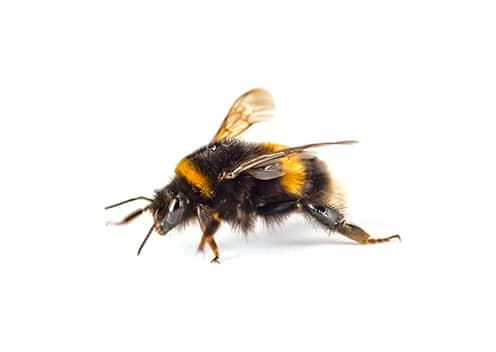
Bumble Bees
You probably know what a bumble bee looks like. It is a fat, furry yellow and black bee. What you might not know is that bumble bees are social insects that usually live underground. If you accidentally disturb a nest on your property, they can swarm and sting you.
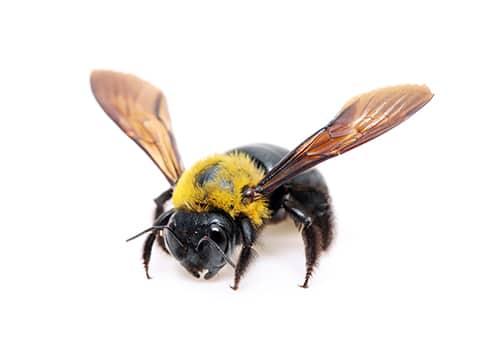
Carpenter Bees
Often times carpenter bees are mistaken for bumble bees. They have a similar appearance but you can tell them apart by looking at the abdomen. A carpenter bee's abdomen is entirely black. Bumble bees have fuzzy, yellow and black abdomens.
This isn't the only surprising fact about carpenter bees. These fat bees, with their bumble bee appearance, can damage the wood of man-made structures by boring circular tunnels into it.
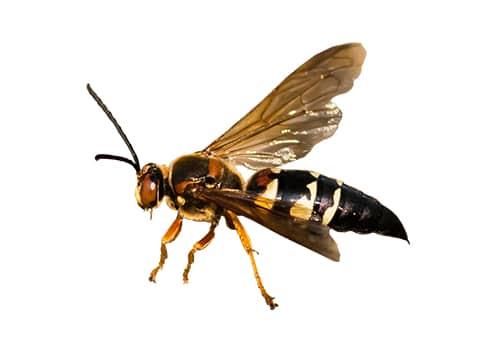
Cicada Killers
These wasps sound scary but, apart from being as large as 2 inches long and somewhat terrifying looking, they are mostly harmless. Cicada killer wasps kill cicadas. They have no interest in stinging you.
They can, however, cause a painful sting if you accidentally sit down on one or put your hand on one.
When these insects establish themselves on your property, they pose the greatest threat to your lawn because they burrow into grainy soils to create their nests. If they create a burrow in a sandbox, this can be a threat to children. So keep this in mind if you notice cicada killer wasps on your property.
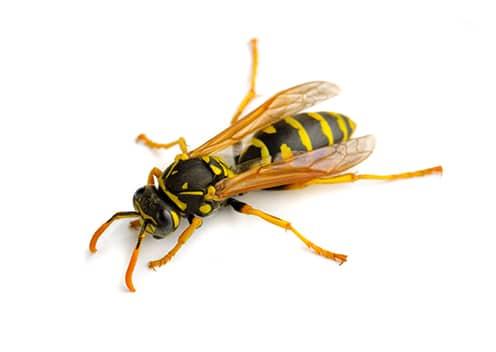
Paper Wasps
These wasps may be brown with yellow markings or brown with reddish markings. The species that have yellow markings look a little bit like a yellow jacket. But they differ greatly from yellow jackets. Paper wasps are far less aggressive and are prone to create aerial nests—not ground nests.
These nests may be attached to tree branches, bushes, rafters, ceilings, overhangs, or the sides of man-made structures. Be cautious around these nests. While a paper wasp can be very docile away from its nest, these social insects will swarm if they feel their nest is threatened.
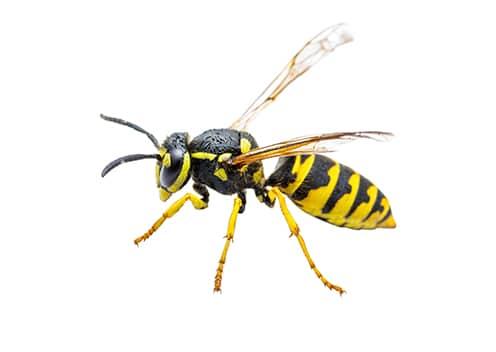
Yellow Jackets
These yellow and black wasps prefer to create ground nests, which they protect fiercely. All it takes is the vibration of a lawnmower to cause a swarm. And unlike the other stinging insects listed here, yellow jackets have been observed pursuing a target and even going around obstacles to get to it.
This makes nest removal a dangerous task. For more information about yellow jackets in our area, check out Why Yellow Jackets are Still Stinging in Virginia and DC, Maryland and Virginia area is seeing more yellow jacket activity.
If you're wondering when you should worry about stinging insects in Maryland, Virginia, or D.C., the answer is quite simple. The threat of stinging insects ramps up during the warmer months and is at its peak in fall.
For many stinging insects, spring is the beginning of a new cycle. During the fall and beginning of winter, most of them die off. It is only fertilized queens that make it through the winter months. These queens emerge in spring and create new colonies.
So you're not going to see a lot of stinging insects in the spring. But as the year moves on, their populations grow and they become more and more of a threat.
During the fall, populations are at their max as these insects busily prepare newly hatched reproductive females (queens) for their long winter sleep. This can make them more aggressive. Instinctively, they know how important this task is. Yellow jackets, paper wasps, and bumble bees are in this category.
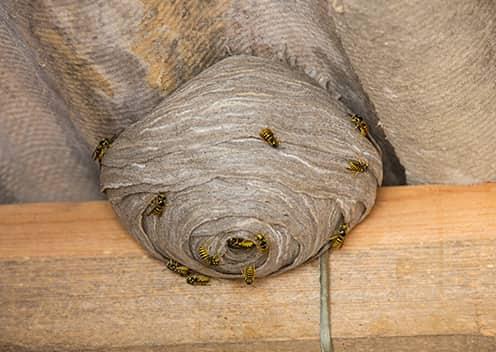
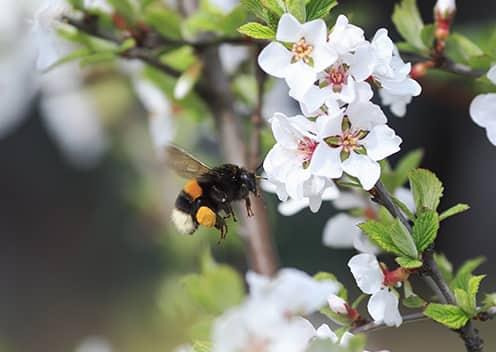
Many stinging insects don't die off in fall and the beginning of winter. Some that would normally die off in colder climates can make it through the winter if they've established themselves in a warm place, such as a piece of furniture stored in an attic space.
Carpenter bees that have infested will remain in the wood of the man-made structure and emerge in spring to bore out a new home—possibly in the same wood. Honey bees that have created a hive in the wall void of a building will consume their honey for energy and come out periodically, when it's warm, to leave excrement.
There are many ways a stinging insect can present a problem. They all present a stinging threat. This threat varies depending on the pest. Some are considered lawn pests because their burrowing activity puts soil on top of the grass and smothers it. This results in dry patches of ground. Some damage wood by boring into it. This can lead to repair costs and personal injury.
There can be a big difference between getting stung by a bee and getting stung by a wasp or hornet, depending on the species of bee. Some bees have a barb on the end of their stinger. Some don't. If a bee has a barbed stinger, it can only sting once.
Honey bees and carpenter bees are examples of bees that have barbed stingers. Bumble bees are an example of a bee that does not have a barbed stinger. These bees can sting several times. So while they are normally a docile insect, they can be a serious threat if you disturb a nest full of them.
No wasps or hornets have barbs on their stingers that are large enough to cause the stinger to become lodged in a wound, so they are all able to sting multiple times. And only females sting. Male bees, wasps, and hornets are not able to sting at all.
Cicada killer bees may sound bad but they fall more into the category of a lawn-damaging pest. They can push a surprising amount of soil out of their burrows. This can create unsightly dead patches in your lawn. While they have impressive stingers and are capable of stinging, these solitary wasps rarely sting unless accidentally trapped.
Carpenter bees fall into this category. In nature, they can be found burrowing into logs, stumps, and in the heart rot of a living tree. When they are drawn to man-made structures by flowers in landscaping, they can become a serious problem for property owners.
They have a preference for unpainted objects and will attack wood that is at least two inches thick. They target decks, railings, fences, window sills, doors, roof eaves, shingles, and more. Each year, carpenter bees bore new tunnels or expand old tunnels to create safe places for their developing offspring.
Some stinging insects eat sweets and meats. While they love the nectar of flowers, they also feed on bugs. A yard filled with bugs is the ideal environment for these stinging pests.
Those stinging pests may be establishing themselves in your yard because there is a nice water hole for them to drink from. They'll use a puddle, a toy that has captured some rainwater, a clogged gutter that has created a tiny pool of water, and other conditions that create standing water in your yard.
Some stinging insects have a preference for grainy soil that is easy to dig into. Sand, loosened dirt, and potted plant soil are examples of this.
A yard that has holes is ideal for stinging insects that create nests in ground holes.
If you have a deck, fence, shed, or some other structure that is unpainted, you could have trouble with carpenter bees. This type of wood is highly attractive.
Stinging insects have complex eyes that can mistake a flower-colored home with flower patterns on it as a beautiful garden of flowers.
Your yard doesn't have to have flowers to attract stinging insects. Sweet smells can lure them in. While sweet smells aren't likely to have them developing nests in your yard, they could draw unwanted attention and lead to a sting.
In our blog, we offer many guides for avoiding stinging pests. We've written a lot on this topic because we want you to be prepared for stinging insects when they come into your yard. While they're usually considered nuisance pests, some individuals have severe reactions to insect venom. And a painful sting can turn into a medical scare. Use these tips to protect yourself:
Always wear shoes when you walk around in grassy areas. It is no fun to step on an unsuspecting bee, wasp, or hornet.
When you go outside, consider refraining from wearing perfume or cologne. Sweet smells can make stinging insects curious about you.
If you look like a flower, you may get unwanted attention. Flower patterns and primary colors catch the attention of stinging insects. They don't have the ability to tell the difference between your Hawaiian shirt and a flowerbed.
If a stinging insect comes near, don't swing at it. Fast motions can scare it into stinging you. Move your arms slowly as you move away or as you encourage the insect to go somewhere else. It is possible to slowly move your arm and have a wasp fly off without stinging you. Fast movements will get you in trouble.
If you enjoy cookouts in your backyard, consider these two prevention ideas to keep yellow jackets and other meat-eating insects from crashing your fun time. Keep meats in a sealed container till you're ready to cook them, and dispose of paper plates etc. in a sealed plastic bags as soon as you're done eating.
If you'll be having a cookout away from home, select your picnic area wisely. Don't set up anywhere near a dumpster. Try to choose a site that doesn't have any leftover food sources in the fire pit.
Stinging insects are attracted by the smell of sweet drinks. Consider keeping your drinks in a cup with a cover or a bottle with a cap.
When you and your family take these precautions, you can limit stinging insects and maximize family fun.
Where do we start? There are all kinds of ways this can go wrong. Some people hang out windows to spray a nest and have wasps come right into their home. Some go up to deal with a nest in the attic and find that trapping one's self in a room with angry wasps is not a good idea.
Some climb a ladder to spray a nest and fall to the ground when the wasps didn't take kindly to having their home sprayed. It is best to get someone with appropriate gear and appropriate training to remove a nest for you.
While this could have been added in with nest removal, it really deserves its own place in this list. Over-the-counter insecticides can be extremely harmful to you, your kids, and your pets. Professionals use protective gear and green methods first, only resorting to least-toxic pest control products when absolutely necessary.
Having a nest developing on your property can sometimes be a problem that is easily ignored—until it can no longer be ignored. Take quick action to address this problem. These insects can reproduce quickly. A yellow jackets' nest, for instance, begins with one queen in the spring and can have as many as 5,000 wasps by the peak of the season.
There are many ways you can prevent stinging insects from creating a nest in your yard, but once a nest or hive has been established, it is best to call an educated and experienced pest professional, one that is appropriately licensed and certified to do the job and one that uses Integrated Pest Management (IPM) methods to resolve delicate pest issues like this one.
Professionals will properly identify what insects you have. This is important because different insects require different methods and products for effective control. Some insects are protected by government regulations because they are important pollinators.
Professionals follow well-established safety guidelines that work to protect themselves and others from harm.
Professionals who implement IPM to control pest problems use green, eco-friendly solutions first and only resort to pest control products when absolutely necessary, such as an infestation that puts an allergic individual at risk. When pest control products are used, they are EPA-approved products that are considered to be least-toxic.
Professionals use field-tested methods to ensure containment of the problem. If there is an unexpected result, such as wasps finding a way into a home during treatment, they are trained to systematically resolve the problem.
Professionals take the responsibility of being hurt. If an accident happens, you don't have to pay for the hospital bills and your home insurance doesn't get hiked up because of an accident on your property that your insurance company had to pay for.
It is never a good idea to turn to DIY for stinging insects problems. It can lead to injury, environmental contamination, and possibly make your problem worse. Trust a licensed and insured professional to tackle this pest problem for you. They are trained to make sure it is done right and that your family is protected.
At American Pest, we offer two types of service. We can provide one-time service or ongoing protection from stinging insects as part of a residential pest control plan. With these services, the process varies, as different species require different treatment methods. In general, you can expect the following:
• Your American Pest technician will provide a detailed inspection and an assessment of the problem to create a plan using advanced Integrated Pest Management methods and EPA-approved products to resolve the problem.
• Your technician is a highly trained professional who wears protective gear as necessary and is up to date on the best options for treating these pests and removing nests.
• All safety guidelines are followed throughout the process of eliminating your problem. This is for the protection of everyone living in your home and also for the protection of the technician.
• Your pest professional may recommend preventative measures to help you prevent future infestations.
While we can help you resolve a stinging insect problem with one-time service, the best solution for stinging insects is our quarterly preventative service.
It not only covers all seasonal stinging insects but gives coverages for over 30 general pests, including rodents. This residential service covers wasps, hornets, cicada killers, mud daubers, and more.
At American Pest, we pride ourselves on being an industry-leading pest control provider. We employ four board-certified entomologists, eleven associate-certified entomologists and over 30 state-certified technicians.
Our field technicians are trained in the most advanced pest control methods and, if they ever run into something they haven't seen before, they have a team of experts standing by to assist them. This means there isn't any guesswork. Your stinging insect problem will be taken care of as quickly as possible.
Our team is also QualityPro and QualityPro Green accredited by the National Pest Management Association. This is a testament to their diligence and hard work as only 3% of the pest control companies in the United States have earned this distinction. It is awarded to companies that show an excellence in business operations, environmental stewardship, consumer relations, employee education, and other key areas.
You can trust our team to resolve your pest problems. Reach out to us today to meet with one of our pest professionals to talk about Preferred Care, Preferred Care Plus, and Preferred Care Complete to find out which one will meet your needs and budget. No home should be without this essential protection.
We align with the best, to bring you the best.




If you have questions about our services, plans, or pricing, we are here for you. Call or fill out the form to communicate by email.